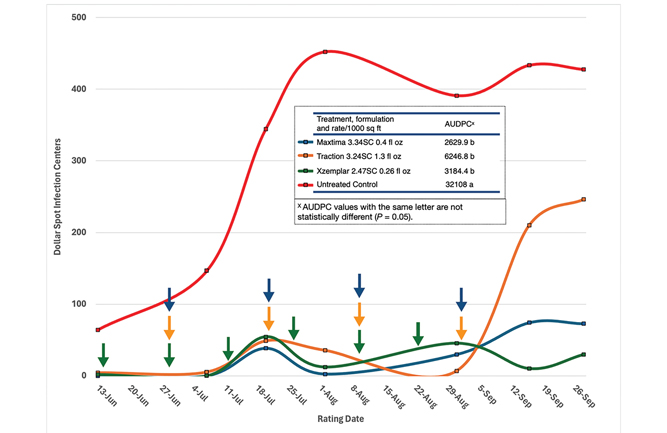Factors affecting the reestablishment of putting greens following winterkill
Winter damage of golf turf is a persistent challenge in the northern U.S., particularly on courses that have higher populations of annual bluegrass (Poa annua). In the last decade, widespread winter damage caused significant turf loss on putting green surfaces across the northern U.S., resulting in costly re-establishment, delays in course openings, and lost revenue.
Reseeding is often a necessary and costly investment to promote recovery and to maintain adequate density and uniformity for play. However, adverse conditions such as cold soil and air temperatures, poor seedbed quality, sub-optimal light intensity and spectral composition typical of early spring plantings can often delay seed germination, diminish establishment vigor and increase competition to weeds and summer stress.
Our research aimed to evaluate factors affecting spring re-establishment of creeping bentgrass, the most widely used turfgrass on golf course greens and fairways in the northern U.S. The objectives were to assess the genetic variability among creeping bentgrass cultivars for post-germination seedling vigor, particularly interactions with low temperatures and variable light intensities typical of spring plantings at northern latitudes. In addition, we examined the effectiveness of chemical priming agents and biostimulants to enhance seedling vigor at low temperatures.
This research will help adjust plant selection and management practices for golf course superintendents to utilize more effective strategies to enhance re-establishment success in the spring months. A unique aspect of our research is establishing an international collaboration with the Norwegian Institute of Bioeconomy Research (NIBIO) and the Scandinavian Turfgrass and Environment Research Foundation (STERF). We have collaboratively defined our research objectives to explore potential barriers more broadly and identify solutions for successful spring re-establishment in northern climates.
We selected 12 creeping bentgrass cultivars representing a range of cold germination or spring green-up traits as identified in our previous research at the University of Massachusetts (UMass) and the University of Minnesota (UMN). Both locations used seed from the same lots shipped by the breeders. We used two general approaches to address our main questions, including testing in climate-controlled growth chambers to simulate early spring stresses as well as field locations at UMass, UMN and Norway to achieve natural stress conditions.
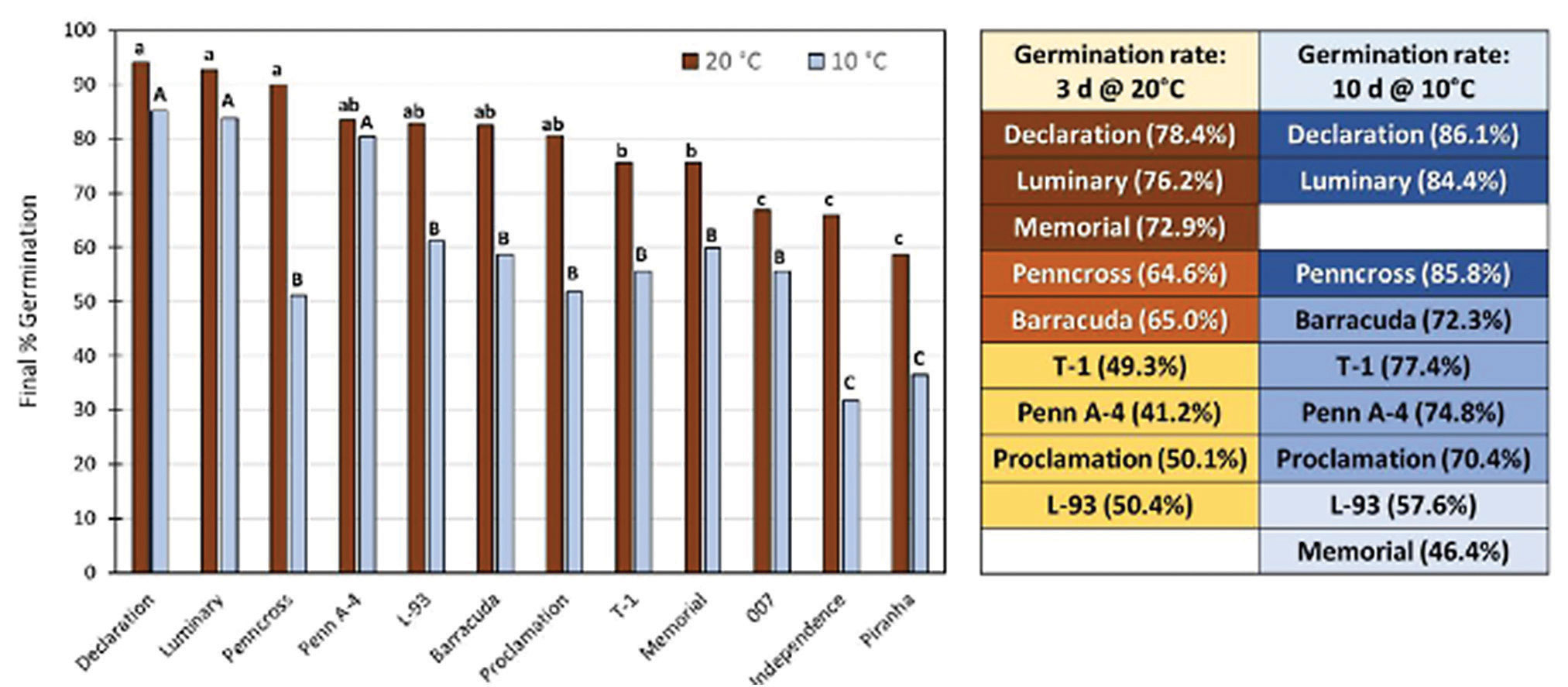
(Fig. 1) Response of creeping bentgrass seedlings grown at 15 degrees C (59 degrees F) for three weeks and then exposed to -5 degrees C (23 degrees F) for eight hours during the dark period. Plants were recovered at 15 degrees C under low or high light intensity for three days and visual quality was used for injury symptoms such as leaf discoloration and wilting. (Graphic: Golfdom staff)
Controlled environment experiments
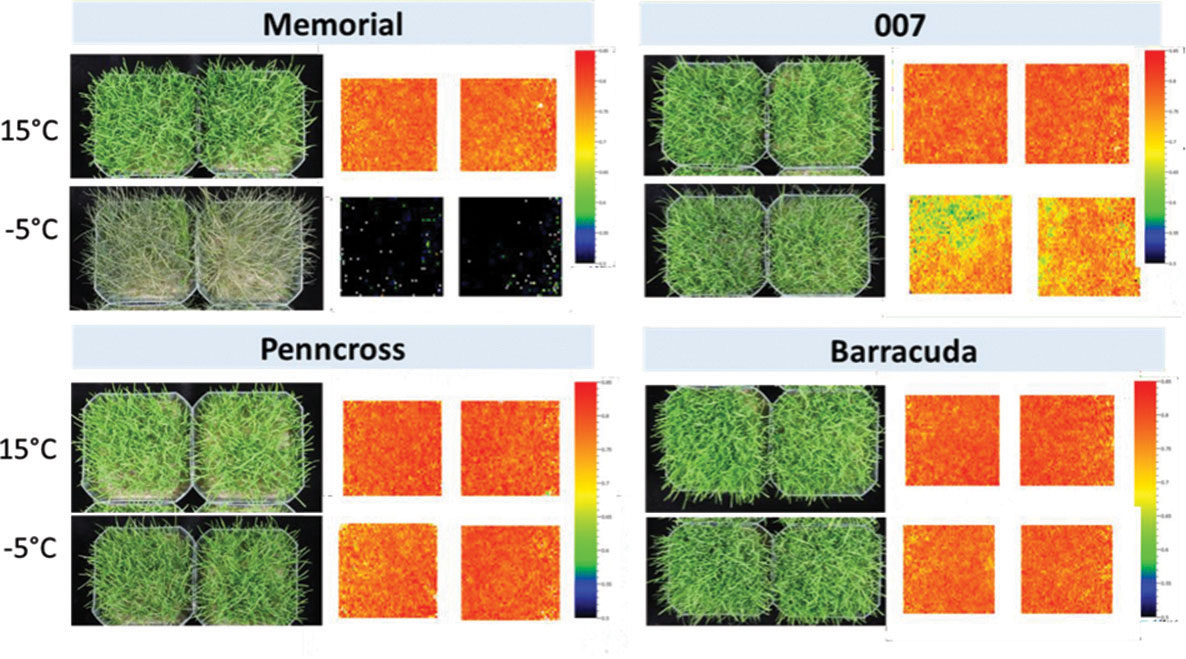
(Fig. 2) Chlorophyll fluorescence imaging of creeping bentgrass seedlings in response to a simulated overnight freezing event at -5 degrees C (23 degrees F). Images represent the measurement of the percentage of photochemical efficiency pre-freezing, and then post-freezing under low or high light conditions. A higher photosynthetic efficiency is indicated by a higher amount of red and orange pixel colors. In contrast, lower photochemical efficiency is indicated by colors of green to dark blue, indicating post-freezing damage to photosynthetic machinery. ((Photos by: Michelle DaCosta)
Although creeping bentgrass is known to have excellent freezing tolerance at the mature plant stage, we do not have a good understanding of whether exposure to freezing temperatures at the early seedling stage impacts overall plant vigor and establishment rate for this species. Therefore, our first sets of climate-controlled experiments were designed to test the post-germination seedling cold tolerance of the 12 bentgrass cultivars exposed to simulated overnight freezing temperatures. Creeping bentgrass seedlings were germinated and grown in pots filled with USGA soil at 15 degrees C (59 degrees F) for three weeks and then exposed to -5 degrees C (23 degrees F ) for eight hours during the dark period. Plants were then recovered at 15 degrees C for three days, and visual quality was used to assess the presence of injury symptoms such as leaf discoloration and wilting. Photosynthetic efficiency based on chlorophyll fluorescence imaging was used as an additional screening tool to detect potential damage to photosynthetic machinery in response to freezing events.
Following freezing at -5 degrees C, the cultivars with the highest visual quality and photosynthetic efficiency included Piranha, Declaration, T1 and Penn A4, while some visual injury was observed for cultivars Barracuda, Memorial, Independence and Luminary (Figure 1). We found that the level of post-freezing injury was worse when seedlings were returned to conditions simulating a higher daytime light intensity, which negatively impacted the photosynthetic efficiency (Figure 2). Although it is important to note that the seedlings recovered following freezing, the data suggest that exposure to freezing temperatures at the seedling stage may temporarily inhibit photosynthesis and growth of some cultivars to a greater extent than others, especially in combination with higher light intensities.
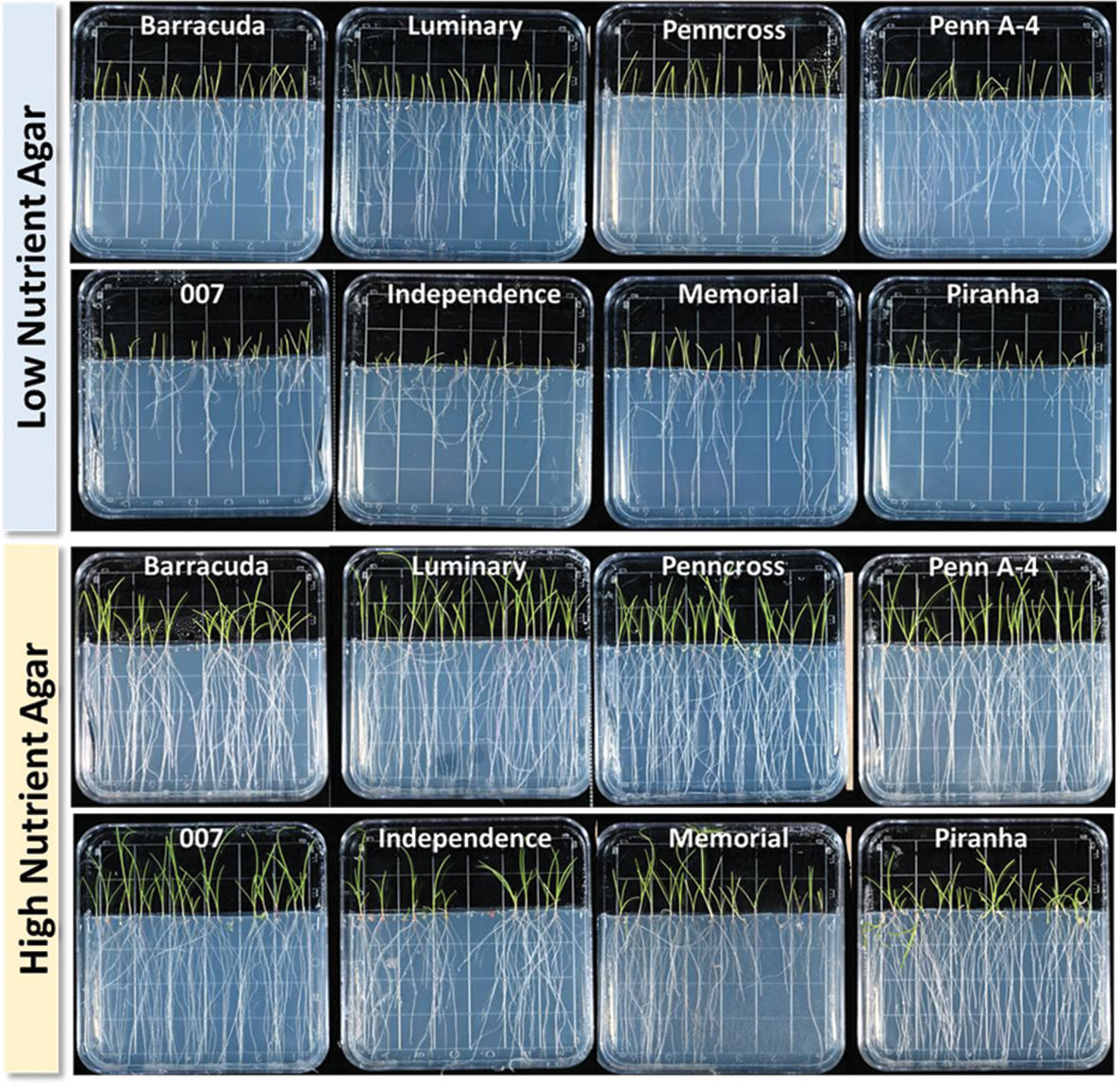
(Fig. 3) Creeping bentgrass seedlings exposed to combination treatments consisting of high or low temperatures (20 or 10 degrees C) and three light intensity levels (800, 400 and 100 µmol m-2 s-1 PPFD). We used light-intensity treatments with shade cloths to reduce 0 to 90 percent light. The top panel photos show plants at seven days of treatment. The bottom panel highlights the growth changes for one cultivar, Memorial creeping bentgrass. (Photos by: Michelle DaCosta)
To gain a better understanding of the interactions of low temperatures and light intensity on seedling establishment, optimization of growth chamber conditions was first required to allow for different light treatments within a single growth chamber. With a maximum chamber light intensity of 800 µmol m-2 s-1 photosynthetic photon flux density (PPFD), we utilized different shade cloth combinations to achieve variable levels of light intensity reduction while minimizing any effects on canopy temperature underneath the shade cloths.
In early spring, light intensity in the field generally peaks around 1,500 µmol m-2 s-1, and while our unshaded treatments were about half of this, 800 µmol m-2 s-1 is well above the amount of light intensity needed to promote efficient photosynthesis in creeping bentgrass. The same 12 creeping bentgrass cultivars were grown for three weeks at 15˚C under a light intensity of approximately 800 µmol m-2 s-1 PPFD. Using shade cloth, we then exposed plants to combination treatments of low or high temperatures (10 or 20 degrees C) and three light intensity levels (0, 50 and 90 percent reduction of full light intensity in the chamber, 800 µmol m-2 s-1PPFD).
The different temperature and light treatment combinations resulted in visible changes in creeping bentgrass seedling growth and development (Figure 3). Under the highest light intensity (0 percent light reduction, 800 µmol m-2 s-1 PPFD), the leaves of most creeping bentgrass cultivars exposed to the low temperature of 10 degrees C exhibited a purple coloration. This response is generally associated with anthocyanin pigment accumulation and is considered a photoprotective mechanism at low temperatures.
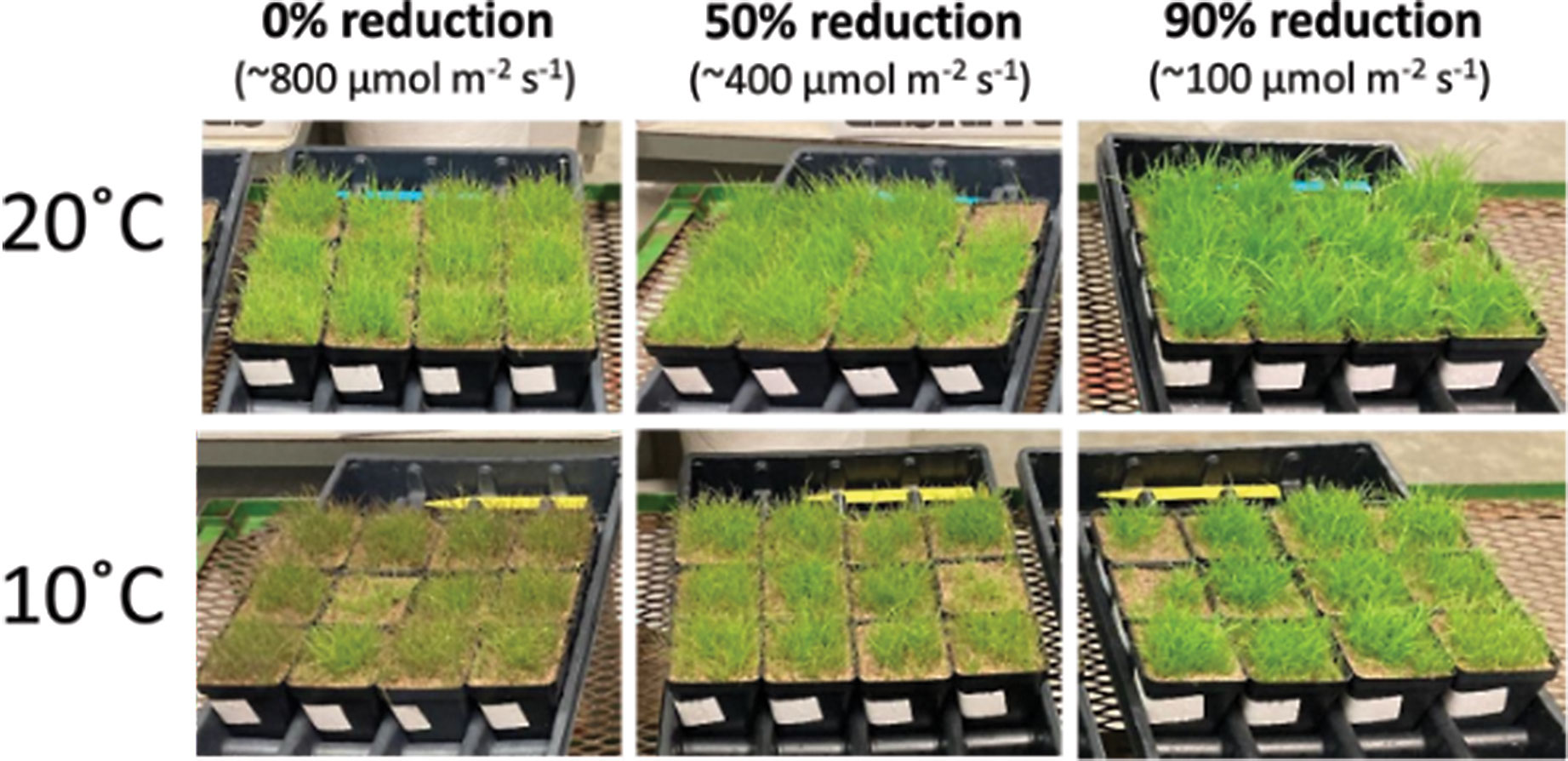
(Fig. 4) Controlled environment experiments using petri dish assays to assess the seedling vigor of different creeping bentgrass cultivars when grown at 15 degrees C (59 degrees F). Seed were sown into agar media amended with either low nutrient (top two rows) or high nutrient solution (bottom two rows). (Photos by: Michelle DaCosta)
Cultivars such as Memorial, Piranha, and 007 produced the most anthocyanin pigment at 10 degrees C under 800 µmol m-2 s-1, while Penncross and Penn-A4 accumulated the lowest amounts. At this same low temperature of 10˚C, creeping bentgrass seedlings exposed to a 90 percent reduced light intensity (approximately 100 µmol m-2 s-1 PPFD) exhibited increased growth and higher photochemical efficiency. For cultivars such as Penncross and Memorial, photochemical efficiency levels were the same at 20 and 10 degrees C, regardless of light intensity. This suggested that covering creeping bentgrass seedlings with 50 to 90 percent shade cloth before a cold temperature event could decrease the potential for low-temperature photoinhibition. To confirm these findings, the effectiveness of light reduction treatments in field environments was also tested, as described below.
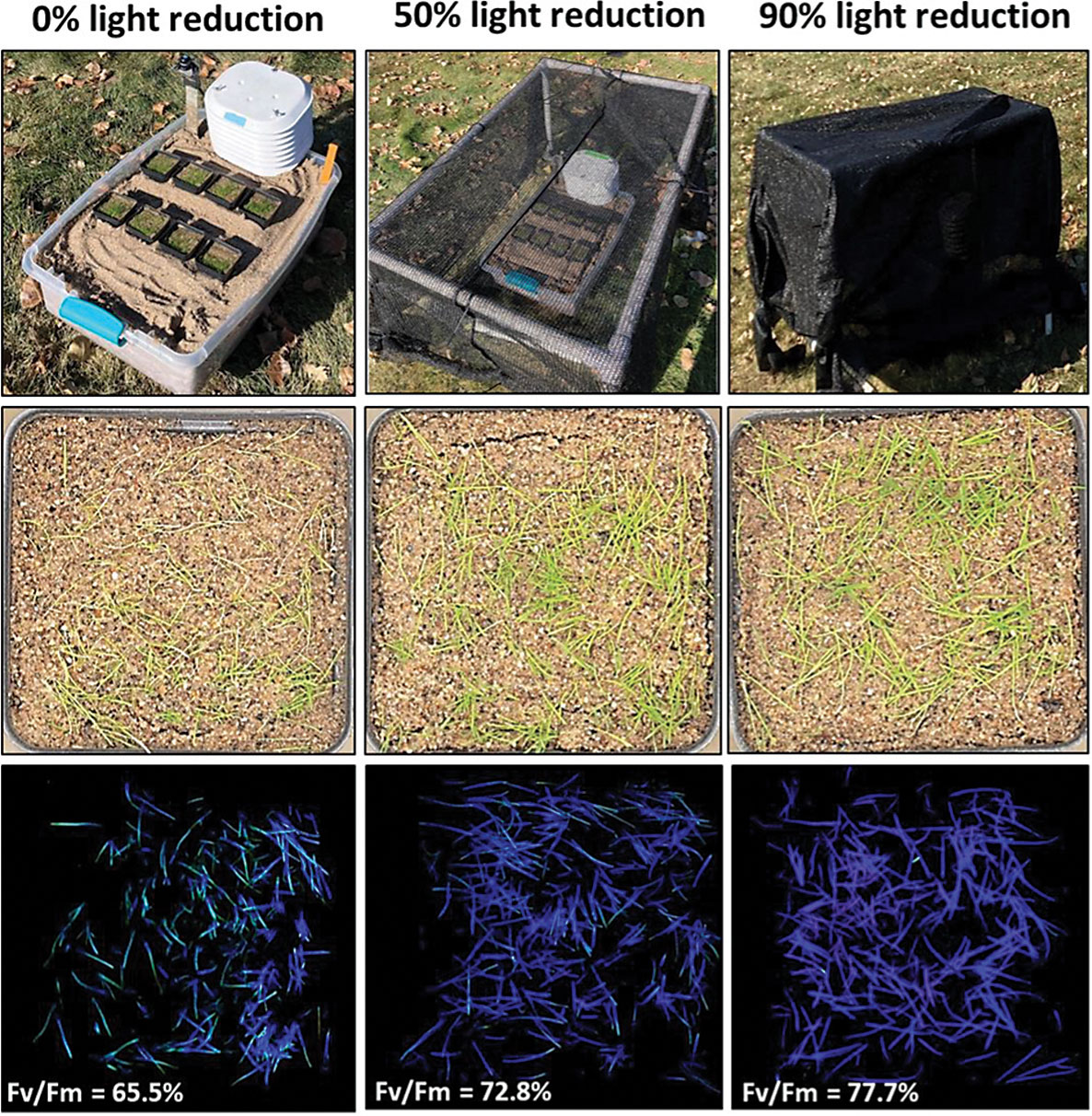
(Fig. 5) Field trials at UMass (South Deerfield, Mass.) and UMN (St. Paul, Minn.) testing the effects of creeping bentgrass genetics and the use of a permeable cover on spring establishment. The top panel shows the effects of cover treatments on increasing time to 50 percent green cover, and the bottom panel includes overhead plot images during the trial period at UMN. (Photos by: Michelle DaCosta)
Next, we tested whether cultivars responded differently to nutrient availability at the early seedling stage. Seeds of each cultivar were established in petri dishes using an agar-based medium. Two nutrient treatments included a non-amended agar (low nutrient) and a nutrient-amended agar (one-quarter strength Hoagland solution). We maintained the Petri dishes with seeds vertically in racks in a growth chamber at either 15 degrees C or 25 degrees C.
Seed germination and seedling growth were monitored for approximately three weeks. As expected, nutrient availability significantly impacted seedling growth at the lower temperature of 15 degrees C, with higher nutrient availability resulting in the highest shoot and root growth across all cultivars (Figure 4).
Differences in seedling vigor were observed, particularly at low nutrient availability, with the highest shoot and root growth observed for the cultivars Barracuda, Declaration, Luminary, Penncross, Penn A-4, Proclamation and T-1. For cultivars exhibiting lower growth rates at low nutrient availability (e.g., 007, Independence, Memorial and Piranha), the availability of nutrients was critical to achieve higher root and shoot growth rates at the lower temperature of 15 degrees C.
Field Experiments
Field experiments were designed to evaluate the effects of creeping bentgrass cultivar and covering treatments on spring establishment. Bare soil plots were seeded with the 12 bentgrass cultivars when average soil temperatures reached approximately 10 degrees C (April 8, 2021, in South Deerfield, Mass., and April 16, 2021, in St. Paul, Minn.) Following seeding, two covering treatments were applied, which included either a no cover or Evergreen Radiant permeable cover. Covers remained on plots until a minimum of 50 percent turfgrass cover was achieved.
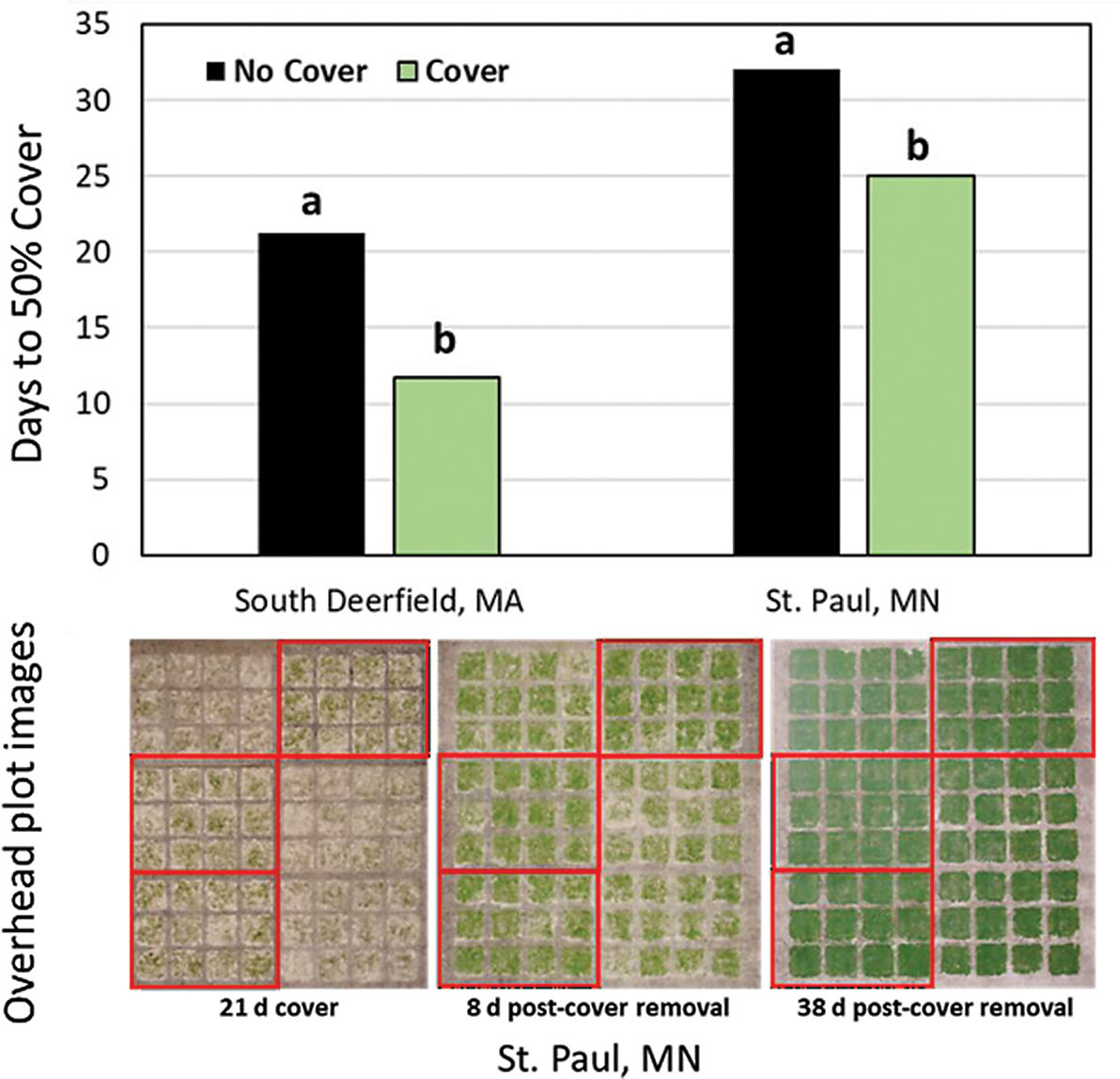
(Fig. 6) We conducted shade trial field experiments at St. Paul, Minn., in March 2021. Shade cloths provided 0, 50 percent, and 90 percent light intensity reduction. The bottom panel shows the effects of shade treatment on the seedling establishment of four creeping bentgrass cultivars, with the 90 percent shade treatment resulting in the highest turfgrass percent cover. (Photos: Michelle DaCosta)
The use of a permeable cover decreased the time to achieve 50 percent turfgrass cover by approximately seven to 12 days, depending on location and regardless of cultivar (Figure 5). This was due to higher soil temperatures achieved under the permeable cover, which were approximately 4 to 5 degrees C higher on average compared to plots with no cover. However, following the removal of covers and by the end of the trial assessment period (early June), there were no differences in the turfgrass percent cover based on the use of a covering treatment. Compared to a covering treatment, the effect of creeping bentgrass cultivar did not contribute to large differences in spring establishment rates.
An additional set of experiments was conducted to examine whether different chemical priming compounds and biostimulants could be used to enhance creeping bentgrass seedling vigor in early spring plantings. Field trials were conducted in 2021 and 2022 at UMass and with collaborators in Landvik, Norway. Luminary creeping bentgrass was seeded when soil temperatures reached 10 degrees C. Treatments were then applied weekly following seedling emergence and included products containing different formulations of urea, chitin, silicon, salicylic acid, glycine betaine, seaweed extracts, and growth regulators such as gibberellic acid and trinexepac-ethyl. Among the 12 treatments tested over two years and two locations, we did not identify any specific biostimulant or chemical priming compound that consistently enhanced early spring establishment.
Lastly, one of the important findings from this research is the identification of important light-intensity interactions for early spring plantings. Based on the initial controlled environment studies, a preliminary field trial was conducted at UMN to test the effects of different shade cloth combinations to achieve 50 or 90 percent light intensity reductions. We seeded the cultivars Memorial, Penncross, Penn-A4 and Barracuda into pots and then placed them into large plastic tubs filled with USGA soil to buffer soil temperature effects in the field.
Similar to growth chamber studies, shade treatment of either 50 percent or 90 percent light reduction improved seedling growth and photochemical efficiency compared to plants exposed to full light intensity, with similar responses across the different bentgrass cultivars (Figure 6). This result suggested that reducing light intensity at low temperatures typical of spring plantings could decrease the potential for low-temperature photoinhibition in creeping bentgrass, particularly in more northern climates. Additional research is underway to better understand these light responses and to determine best practices to translate this information for golf turf management.









